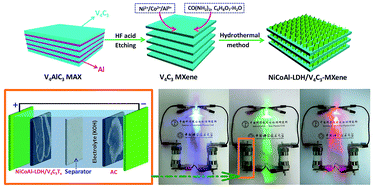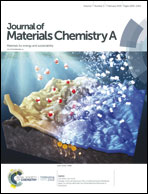Heterostructures of Ni–Co–Al layered double hydroxide assembled on V4C3 MXene for high-energy hybrid supercapacitors†
Abstract
An energy storage system based on a battery-type electrode and a capacitive electrode as a hybrid supercapacitor offers a promising way to construct devices with advantages of both rechargeable batteries and carbon-based supercapacitors. NiCoAl-LDH nanosheets uniformly grow onto micron-scaled MXene sheets to form a NiCoAl-LDH/V4C3Tx heterostructure with three-dimensional interconnected porous network microstructures by a hydrothermal method. NiCoAl-LDH/V4C3Tx composite electrodes show an excellent specific capacity of 627 C g−1 at a current density of 1 A g−1 in 1 M KOH. Especially, the NiCoAl-LDH/V4C3Tx electrodes exhibit a specific capacity of 300 C g−1 even at a high current density of 20 A g−1 in 1 M KOH, showing excellent rate performance. Hybrid supercapacitors, constructed with NiCoAl-LDH/V4C3Tx as the battery-type electrode and activated carbon (AC) as the capacitive electrode, show superior energy densities of 71.7 and 45.0 W h kg−1 at power densities of 830 and 20 000 W kg−1 in 1 M KOH, respectively. The excellent capacity retention rate is 98% for the hybrid device after 10 000 cycles at 20 A g−1 in 1 M KOH. The NiCoAl-LDH/V4C3Tx heterostructures can be used as promising electrode materials for low-cost hybrid supercapacitor devices.



 Please wait while we load your content...
Please wait while we load your content...